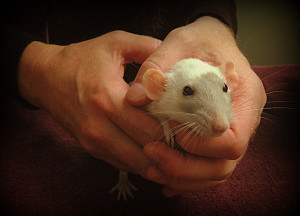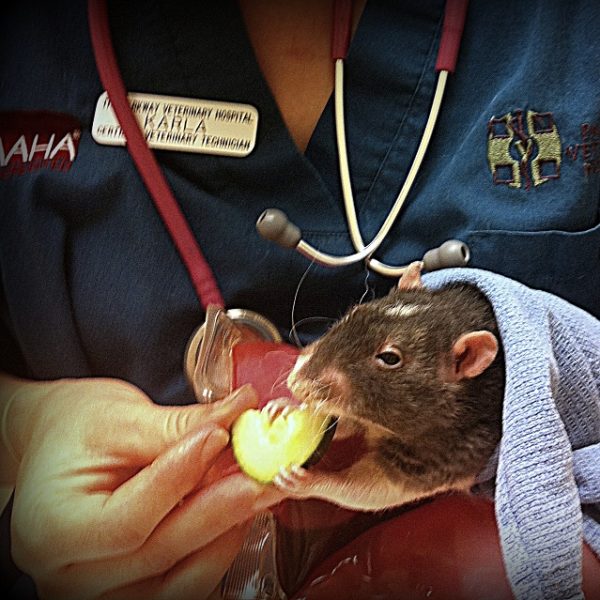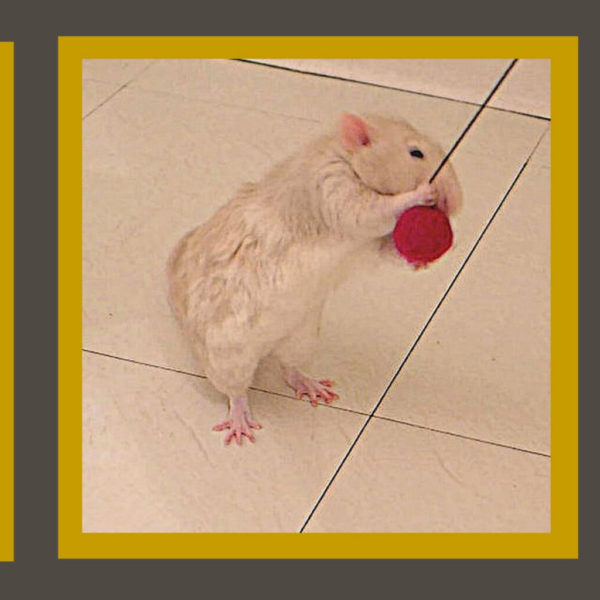 External parasites in pet rats are fairly easy to prevent. Keep your rats’ cage and room immaculately clean. Disinfect their cage weekly. Despite maintaining a rigorous cleaning routine, any new rats you bring home could have external parasites. Likewise, commercial rodent bedding, litter, or food can harbor parasites. (Get tips on how to prevent this below*.)
External parasites in pet rats are fairly easy to prevent. Keep your rats’ cage and room immaculately clean. Disinfect their cage weekly. Despite maintaining a rigorous cleaning routine, any new rats you bring home could have external parasites. Likewise, commercial rodent bedding, litter, or food can harbor parasites. (Get tips on how to prevent this below*.)
Types of External Parasites in Pet Rats
Mites are the most frequent external parasite found on pet rats. Less common are lice, fleas and, very rarely, ticks. One of the main symptoms is itchiness. Keep in mind, however, that allergies to food, bedding and/or other environmental triggers can also cause itchiness. If your rats do have external parasites, eliminate them quickly as they can cause disease and/or internal parasites.
Mites

If all your rats are itchy and have scabs, they are likely to have mites. An exception may occur when you have a rat who is stressed, ill and/or elderly. They may show symptoms of mites without the others being bothered at all. In this case, your elder rat may have a compromised immune system, making him or her more susceptible to mites.
Here are the various types of mites your rats may encounter:
Rat Fur Mites (Radfordia ensifera)
Fur mites are the most common type of mite found on pet rats. They are often normally present in small numbers without causing a problem. Mites as a cause of your pet rat’s itchiness are actually very difficult to diagnose. Your veterinarian may do a skin scraping or adhesive tape test and look at the samples under a microscope. However, these tests don’t always show mites even if they are present. Some vets choose not to do these tests and instead go straight to a treatment to rule-out whether mites are present. (Continue reading to learn the most effective treatments used by rat-knowledgeable veterinarians.)
Ear Mange Mites (Notoedres muris)
Ear mange mites are much less common than fur mites. The symptoms of ear mange mites are crusty, scabby ears, nose, tail and sometimes feet. These mites burrow into the skin and are microscopic in size and, (same as the fur mite,) live only on rats.

Tropical Rat Mites (Ornithonyssus bacoti)
The least common type of mites found on pet rats, the tropical rat mite can bite humans and other animals as well as rats. Once engorged with blood, they are visible to the human eye. Their color is generally dark red, brown or black. Tropical rat mites reside in cracks around the cage and only crawl onto a rat for a meal.
Treatment for Mites
The best treatment for mites is Revolution, a topical medication prescribed by your veterinarian. Even if skin scrapings and adhesive tape tests are negative, your vet may still prescribe Revolution. No harm is done by using this medication, even if it turns out your rat does not have mites. In fact, applying Revolution can help determine if mites actually are the cause of your rat’s itchiness.
Besides Revolution, Ivermectin and Mitaban are other medications that may be prescribed by your veterinarian depending on the type of mite and degree of infestation.
An alternative treatment for ear mange mites is the use of diatomaceous earth and Vaseline. Meg, the young rat pictured above, was prescribed Ivermectin by her veterinarian to rid her of ear mange mites. When after several days Meg’s condition did not improve, her veterinarian recommended sprinkling her with diatomaceous earth (DTE) and applying Vaseline to the scabby areas. DTE causes insects to dehydrate and the Vaseline smothers them so they cannot breathe.
Lice
Lice are less common than mites. They can cause rats to scratch themselves as well as to lose fur. Rats don’t usually develop scabs when they have lice. Lice are usually found on rats’ neck shoulders and back where it’s difficult for them to reach. They are visible without using a microscope, although a magnifying glass helps for viewing them. Tan or yellow in color, lice can sometimes have brown or red spots on them. Lice eggs are a silvery color.
Treatment for Lice
The most used treatment for lice is oral Ivermectin. However, Revolution also works to rid rats of lice.
Fleas
Fleas are even more uncommon than lice. Their presence usually signals there is a dog or cat in your household with fleas.
Ticks
Of all the external parasites in pet rats, ticks are the least likely. Similar to fleas, a rat would only have ticks if another pet in the household (such as a dog or cat) has them.
 Treatment for Ticks and Fleas
Treatment for Ticks and Fleas
Make sure your non-rat pets are all on high quality flea (and, when indicated, tick) preventatives. Over-the-counter products are not always effective or safe. The best flea and tick preventatives are those recommended by your veterinarian. If your dogs and cats are flea and tick free, your rats will be too.
Medications
Any medications used must be prescribed by your veterinarian. An exam with a veterinarian (who’s experienced and knowledgeable about pet rats) is an important first step to getting diagnosed and receiving the proper medication. Finally, it is safest to purchase all medications from your veterinarian rather than online or from a pharmacy for humans.
In addition to the above treatments for external parasites in pet rats ~
Cleaning
If it’s suspected that all of your rats are affected, you’ll want to completely empty their cage and clean and disinfect all the contents as well as the cage itself. Discard anything inside the cage that’s wooden or cardboard. If there’s carpet in the room, it’s a good idea to have it cleaned professionally if you can. Professional carpet cleaners are usually relatively inexpensive and can do the cleaning in a very short amount of time.
It’s important to clean and disinfect your cage and its contents at least once a week anyways.
Sharp Toenails
Keeping your rat’s toenails trimmed will help prevent self-inflicted scratches and wounds. Broken skin created by scratching allows bacteria to enter. Once scabs form, they can become itchy themselves, resulting in an endless cycle of more scratching, more broken skin, bacteria and scabs. Some rats need their toenails trimmed as much as one or two times per week.
Skin Infection

Infection occurs when the skin is damaged by scratching or bite wounds. Staphylococcus bacteria causes the most common skin infections. Rats with weakened immune systems are more likely to develop skin infections. Inflamed skin and sores most often occur on the head and neck. Abscesses can form and spread the infection under the skin. Eventually lumps or tumors can develop around the rat’s head. These types of infection are treated with antibiotics and often combined with steroids to help curb inflammation.
Overall Tips for Preventing External Parasites in Pet Rats
- Take your rats in for regular well-rat exams at least once every six months
- *If you use prepackaged processed litter, freeze the bag’s contents before using
- Freeze lab blocks then thaw and feed—especially if you believe the contents of the bag may have been exposed to parasites
- Keep your rats’ cage clean and disinfected on a regular basis
- Quarantine all new rats. Three weeks is a good amount of time in which to prevent your existing rat(s) from being exposed to external parasites
- After visiting with any rats outside your home, wash yourself well and to change clothes prior to handling your own rats
- Keep your home free of wildlife, particularly wild mice and rats. If you have wild mice and/or rats in your home, find out where they’re getting food. Make sure all food inside your house is in airtight bags or containers. Do not place any food outside for your dog and/or cat. Outdoor bird feeders frequently attract wild rats. When the seed falls onto the ground it serves as a delicious snack for wild rats.









Hi Jasmine,
Thank you for your reply. Yes, I tried diatomaceous earth, cedarcide, mite-be-gone, ivermectin, permethrin, Vaseline, coconut oil, and many other things, nothing has worked! Any other suggestions?
Thank you.
Hi Ebbie,
You’ve done an impressive job exploring different options and trying to help your dog—your dedication really shows. At this point, I strongly believe the best next step would be finding a veterinarian who can provide more targeted support. I understand you’ve already seen at least one vet, but I’m confident there is someone in your area who can get to the root of your dog’s skin/external parasite issues and recommend the right treatment.
If it would be helpful, I’d be more than happy to assist you with researching other veterinary options in your area. Just let me know, and I’ll gladly help you find someone who might be able to help.
You’re doing everything you can, and your dog is lucky to have you advocating for him!
Warmly,
Jasmine | About Pet Rats
Hi, I know you advise on rats, but I felt this was related, and I’m getting desperate! I believe my dog caught rat mites from a dead rat in the backyard. He’s going insane scratching and biting, sometimes he rips his fur off. They bite me at times as well. Nothing has worked, we’ve tried Revolution, Bravecto, Spinosad/Comfortis, Simparica Trio, and many other flea and tick meds to no avail. The vets, even a vet-derm can’t figure out how to get rid of them. Please help!
Hi Ebbie,
I’m sorry to hear both you and your dog are getting bitten by mites. I’m surprised that Revolution hasn’t helped. Have you tried Diatomaceous Earth? To me, that seems like a viable option.
As you stated, I’m not an expert on dogs, but I’m hoping Diatomaceous Earth can be a solution for you and your dog.
I hope this is helpful!
Best Wishes to You & Your Dog,
Jasmine | About Pet Rats
Hi there! I am a new time rat owner. I am adopting 2 male rats this weekend! I am so excited but recently I have been watching videos and getting more information of Tropical Rat Mites and it’s troubling me. After reading, I am now scared of adopting my rats. First off, how can I prevent Tropical Rat Mites? Where do they come from? Is it okay to keep my rats in my room? If my rats get Tropical Rat Mites, then I would literally have to burn my room. I am just a little stressed out about this. I had rabbits, who then got fleas and it was the worst moment in my life. I don’t know if I could go through it again, especially if the Tropical rat mites could be in my room or in my BED!!
Thank you!
Hi There!
I’m glad you asked your question about tropical rat mites. In my post above, I wrote that tropical rat mites are the least likely to be found on pet rats. So, tropial rat mites are not something you likely need to be overtly concerned about.
I’ve been a pet rat owner for 34 years. During this time my rats have only had fur mites 2 (or at the very most 3) times at most. My rats have never had tropical mites.
Of course, if you live in an area that has a warm climate year-round, the chances of your rats getting mites may be increased. Also, if you’re getting your rats from a place that hasn’t been kept clean, this could also affect whether your new rats come to you with external parasites
If they do come with external parasites, your vet can help you get rid of them. It’s not that difficult.
Once you have your rats with you, cleaning and disinfecting the cage weekly makes a huge difference.
Don’t hesitate to let me know if you have any additional questions or need any clarification on what I wrote here.
Best Wishes to You & Your Rats,
Jasmine | About Pet Rats
Hey there, question… So breed rats for snake food (i absolutely hate it but i have no choice and i do it right and very humanely) i had rats purely as pets before i started breeding but anyway my rats have contracted mites, but i need something natural that won’t hurt my snake or that i will have to wait for it to get out of their system. so i need something completely safe and natural for the rats and the snakes. any ideas???
Hi Gracie,
As mentioned above, there are different types of mites and various choices of how to treat. It’s best to consult with a veterinarian who’s experienced with and knowledgeable about pet rats.
Take Care,
Jasmine | About Pet Rats
Hello! My husband and I recently rescued a rat, he’s brown with a white tummy and a white tip on the end of his tail. About a month or more ago, he started itching badly, making himself bleed even. I can’t clip his claws… but in doing a lot of research It sounded like he has mites. Little white specks all over him even directly onthe skin. I’ve been giving her ivermesin (forgive the spelling) for 3 weeks now. And no change. What is the medication: Revolution? Maybe that will help more since it’s drops on the back of the neck? I’m also cleaning his enclosure every day and bathing him (to the best of my ability, he HATES bathes)
Any help you could offer me would be great especially with what brand of revolution and dosages etc. I see many that are for cats or dogs.
Thanks!
Hi Tess,
Are you able to take your rat to a veterinarian who’s knowledgeable about and experienced with pet rats? That would be the ideal way to help him.
Revolution is available by a veterinarian’s prescription only. It’s also a great idea to establish a good relationship with a vet for your rat’s care, anyways.
That’s wonderful that you’re keeping his enclosure clean on a daily basis. It really does make a difference.
If you’re unable to take your rat to a veterinarian, this site has excellent information on Revolution and proper dosages. It really is best, though, to have him checked out by a well-qualified rat vet.
Let me know if you have any additional questions anytime.
Best Wishes to You & Your Rat,
Jasmine | About Pet Rats
Revolution. use twice few days apart.
It worked perfect on my rat.I took him to vet and besides revolution he gave my rat some antibiotic too. 😃
..
Hi Krystina,
Thanks for sharing your experiences.
My vets have not prescribed Revolution to be repeated as often as a few days apart. Usually it’s a monthly application, at least from my experience. Also, I haven’t seen antibiotics prescribed for rats with external parasites before. Did your vet prescribe the antibiotics because there was severe scabbing and they were worried those areas could become infected?
In any case, I do appreciate your sharing your experiences. We can all learn from one another.
Best Wishes to You & Your Rats,
Jasmine | About Pet Rats
Hi, I have a general question regarding rat safety. I have recently( 10 days ago) adopted two baby rats(7wks old) from a friend of a friend; they are sisters and very sweet, though still nervous.
My concern is that I do have a young child and my husband and I are planning to have another baby very soon. I’m worried I may have jumped the gun on rescuing these girls as I cannot stop the paranoia of certain illnesses such as rat bite fever from entering my mind. I’ve had rats all through my teen years and into early adulthood which is why I was so excited to get these girls, however I have not had rats and children at the same time. All the info I can find is what a terrible idea it is as though streptococcal bacterial infection is imminent and that when pregnant I shouldn’t even clean their cage. This is causing some doubt in my ability to socialize with them properly and am even considering rehoming them while they are young and adaptable. I suppose my real question is, have you had any personal or had anyone write to you regarding this or other common illnesses resulting from pet rats? Any opinion is greatly appreciated. I really want the best for them and for my family as well.
Hi Tara,
What a great question!
To start, I’ve had rats for 33 years and I’d never heard they could cause any potential disease risks for pregnant women. I’ve always known that pregnant women should avoid scooping cat litter due to toxoplasmosis, but never knew anything to do with rats could cause a problem.
After reading your question, however, I did some research. The CDC has an article on their website stating “Rodents (like mice and hamsters) can carry lymphocytic choriomeningitis virus, which can cause birth defects.”
They state that “If you’re pregnant and already own a pet rodent or cat, you don’t need to rehome your pet. Making some small adjustments to your routine can help keep you safe from illness.”
The CDC goes on to say: “Avoid direct contact with your rodent and its habitat during your pregnancy. If possible, have someone else in your household care for the rodent. If that’s not possible, wash your hands after handling the rodent or its supplies.”
Another article I read said that “Natural LCMV reservoirs are laboratory and wild mice. Most rodents are susceptible to infection, with hamsters especially sensitive to infection, while rats are naturally resistant.”
There are several different rat forums where topics such as this one are discussed. On Rat Forum, the consensus was that it’s okay to continue having pet rats. It’s a good idea, however, to be sure and wash your hands after contact. While cleaning their cage you can wear gloves and even a face mask if it helps you feel safer.
Finally, I have to let you know I my current 2 female rats were adopted from a woman who’d recently had a baby. She had her rats while pregnant and didn’t mention any concerns about how having rats could’ve affected her baby and/or pregnancy. The reason she rehomed her rats is that she also had a cat and a dog. She was having a hard time keeping up with all of their care.
Which is something to really think about, in my opinion: Will you have the time and energy to care for 2 small children AND 2 rats? Only you know the answer to this question.
I’m a firm believer that pets (of any kind) are an important and very positive part of childhood. Most children who have pets develop more compassion. As you know, being around animals greatly enriches our lives whether we’re adults or children.
If it were me, I’d keep them and exercise the normal amount of caution we all should all be using anyways. (Washing our hands, keeping their cage super clean so no urine or feces build up, etc.) I’d also check with your doctor—and maybe you already have.
I really appreciate your asking such an important question. I hope my response is helpful. Don’t hesitate to let me know if you have any other questions any time.
Best Wishes to You & Your Rats,
Jasmine | About Pet Rats
Thanks for the info! My dumbo/rex is experiencing patchy hair loss on her back and has a kind of orange looking discoloration on her skin – she’s on week three of three with her vet recommended Revolution treatment, but doesn’t seem to be improving. She’s not super itchy, but the discoloration has increased since I first noticed it. Any suggestions?
Hi Jaimee,
You mention that your dumbo/rex is experiencing patchy hair loss on her back. I’m wondering if she might be a Double Rex? Double Rex are similar to Rex rats. The difference is they continually develop hairless areas on different parts of their bodies. The areas which are hairless can change—-they can grow fur in a previously hairless area and then loose another patch of fur in a different area of their body.
Regarding the orange discoloration on her skin, this is called buck grease. Buck grease is usually found on males but some females do get it too. The orange oily discharge is usually caused by excess testosterone. Some people believe that adding Omega 3 fatty acids to a rat’s diet can help diminish buck grease. To do this you can mix a drop or two of olive or flaxseed oil in with their normal food. (i.e. Mix it in with a little human food such as whole grain rice or a small piece of bread. If you use bread, make sure it’s a tiny piece that’s flat rather than squished into a ball. They can easily choke on food that’s doughy and sticky like bread or that’s chunky and sticky like peanut butter.)
Usually external parasites will cause itching which can also result in tiny scabs on their bodies. The scabs are a result of scratching themselves. It’s helpful to keep their back toenails trimmed so they can’t cause as much scabbing when scratching at themselves. Orange-colored skin and balding spots, however, are not signs of parasites.
What made your vet think your rat has external parasites? If your vet thought she had parasites because she has orange-colored areas on her skin, or because of her patchy hair loss, your vet may not be a veterinarian who’s knowledgeable about and experienced with pet rats.
I hope my response is helpful for you. Let me know if you have additional questions or need any clarification.
Best Wishes to You & Your Rats,
Jasmine | About Pet Rats
My wife and I have two pet rats, and there is something in the ear of just one of the rats. It is some kind of growth that is brown, and it is only in his one ear. He scratches at it every now and again but not enough to cause scabs. We’ve done a lot of research as to what it could be and tried treating him for ear mites but it’s not gone away. Our other rat hasn’t gotten it either so it doesn’t look like it’s contagious (whatever it is). Any suggestions before we take him to a vet?
Hi Neiman,
It doesn’t sound like your rat has ear mites or any other external parasite. If it’s a growth, it may be some sort of tumor. Your vet will likely recommend removing it.
Feel free to ask further questions if you have any as well as to post an update after you take your rat to a vet. I hope it’s not too serious of a problem!
Take Care,
Jasmine | About Pet Rats
Last night my wife noticed tiny bugs out on the tips of our rat’s fur. They are very small, reddish brown, and move slowly. There were many more down on the rat’s skin. They just looked like little brown spots, not obviously bugs. We have noticed that where we have been holding him, the bugs seem to crawl out onto the ends of the hairs as if they are attracted to the warmth. A bunch of them dropped off onto my shirt where I was holding him this morning. Our rat has been scratching some, but we haven’t seen any scabs. We tried giving him a bath with a little soap, and he didn’t mind particularly, but it did not significantly impact the bugs. I wonder what these could be, since you say that most external parasites on rats are not visible.
We will be calling a vet Monday morning to try to get a same-day appointment with a vet who knows about rats. Advance appointments are about a week out.
Hi John,
I hope you were able to get your rats into the vet without having to wait too long for an appointment.
The only time I’ve ever encountered tiny bugs that looked like “brown spots” was when I was living in Pennsylvania. I was just a child and was reading “Charlotte’s Web” in bed. A few little brown spots were moving on the pages of my book! Turned out they were mites from a bird who’d nested in the walls of my bedroom.
In any case, you are right that most if not all rat parasites are not visible without doing a skin scraping and then viewing them with a microscope. I would be interested in hearing what your vet has to say. If they are indeed some sort of parasite, I’m thinking your vet will probably prescribe a topical medication such as Revolution.
You’ll also want to review your cage cleaning routines and schedule. Keeping the cage spotless and disinfected regularly really does make a difference.
Feel free to post and update and let us all know about what your vet says after examining your rats.
Best Wishes to You & Your Rats,
Jasmine | About Pet Rats
The vet examined the bugs under a microscope and they were indeed lice. We were given Ivermectin to give orally, and an Ivermectin spray for the enclosure. A lot of dead bugs dropped off him the next day while I was cleaning his enclosure.
I don’t know how he got the lice. Possibly when we let him wander around the planting bed next to the house. We frequently see rabbits and sometimes squirrels in our yard. Maybe from the aspen bedding we bought a month ago (seems unlikely, but we have ditched the aspen shavings and are switching to washable polyfleece). We did have a small dog visit the previous week, but lice are not transmissible across species avoiding to our vet.
Hi John,
Thanks for the update on your vet letting you know your rat did actually have lice. I’m so glad you were able to get him in to see your vet so quickly. Ivermectin can be a very helpful medication.
In general, I prefer not to allow my rats to wander around loose outside. There are too many dangers.
It is interesting to wonder how your rat got lice. If they’re not transmittable across species, I wonder if it could be from wild rats if your rat was outdoors?
Thanks again for the update. It’s really great to hear how things turned out. You sound like a wonderful caregiver for your rat.
Best Wishes to You & Your Rat,
Jasmine
Hello my name is Tracy. I have 3 male rats and 3 female rats. I keep them separated, males with makes and females with females. One of my rats had babies (have no idea how she got out and I found her in the makes cage, fixed the problem though). All of my rats butt one have no bites or scans and do itch more then normal. The make that does had been getting scabs around the back of the neck and some down his back. He is the only one and at least check he only has s couple small scabs behind his ear. My daughter took 2 of the babies home with her and today she told me that they had very very very small bugs crawling on then. She sent me some pics and to me they looked exactly like lice. Long body feet towards the top of body but we are not sure as I’ve never seen lice this tiny. Barely even viable. Doing research I found that many day it’s very very unlikely that the rats will have lice and then others say yes they can and it is common. Also are human head lice the same thing or are the lice that my search s keep pulling up a different type of live? Help pkease
Hi Tracy,
Lice are not common on pet rats. Also, most external parasites on rats are not visible—-they are too small and can only be observed under a microscope.
My best advice is to take the rat with scabs to a veterinarian who’s knowledgeable about and experienced with pet rats. After a thorough exam, as long as the rat is healthy and the vet determines there are external parasites causing the rat to itch, usually Revolution or something similar would be prescribed. This is a topical medication that’s only available through veterinarians.
I hope my response is helpful. Don’t hesitate to let me know if you have any additional questions.
Best Wishes to You & Your Rats,
Jasmine | About Pet Rats
We just lost one of my daughter’s rats tonight. We had been trying to get in to see our vet, but with the COVID precautions, it was going to be a week away still. We had developed large scabs on her face, but we had not noticed any aggressive or more frequent scratching. When my daughter held one of the other rats tonight, it looks like mites were left on her shirt. This has never happened before.
Is there something we should do before we see our vet?
Hi Jay,
I’m so sorry to hear you lost one of your daughter’s rats.
Regarding your other rat leaving what looked like mites on your daughter’s shirt, in most cases the parasites found on rats are microscopic.
One thing that can really help keep down the likelihood of any parasites is cleaning the cage super well.
I’m glad you will be taking her to the vet. It really does help to have rats examined regularly by a veterinarian who’s experienced with and knowledgeable about pet rats.
In case it’s helpful to know for the future, once a rat becomes an established patient in a veterinary hospital you’re more likely to be able to get an appointment fairly quickly whenever there’s a problem.
Let me know anytime you have any other questions.
Sending heartfelt condolences to you and your daughter and positive wishes for your rat who will be seeing a vet soon.
Jasmine | About Pet Rats
My daughter has two rats. When she comes up for a visit she puts them in a big home made cage here. Last time she had them over it seemed to me they were scratching more than usual. I don’t see any signs of scabs or parasites at all. But I’m guessing mites and lice are so small they could be missed. It also seems last time she was here my wrists and neck (one loves to snuggle) were itchy after handling them.
I’ll be doing more reading but meanwhile, how does one disinfect a very large, oh nearly 5′ tall cage made of pvc and heavy wire? It sits in a deep plastic tray which I do clean after every visit. But the pvc where the wire wraps around? Not like this can be wiped down. She (and rats) are gone for weeks at a time so maybe I could spray this down with something? It would be dry by the time she returns. What is safe? don’t want rats licking off some chemical.
Dear Jen,
Thanks so much for your question.
In most cases scabs do appear when rats are scratching themselves because of external parasites. I’m sure there are exceptions, though. The fact that your wrists and neck were itchy after handling them could actually be a sign that you’re becoming allergic. If your daughter’s rats do, indeed, have external parasites, it’s important they be seen by a qualified veterinarian (one who’s experienced with rats). Their veterinarian may prescribe Revolution or Ivermectin to get rid of the parasites.
I’m almost finished with a page I’m adding to my website on cleaning and disinfecting pet rat cages. It’s a good idea to do this on a regular basis (and especially when there are external parasites present). I’m including a preview here with the details most pertinent to your question:
Supplies Needed:
1st bottle) Dishwashing detergent (Dawn works exceptionally well due to it’s grease cleaning capabilities)
2nd bottle) Oxyfresh Cleansing Gelé – a disinfectant that contains stabilized chlorine dioxide and bactericidal, virucidal, and fungicidal properties. Despite being so powerful, it’s not toxic like bleach or ammonia. It’s so safe, it’s used by many bird owners for disinfecting their bird cages. There are other disinfectants you can use, but I believe Oxyfresh is both the most powerful and the safest
Decide WHERE you want to clean your pet rats’ cage – The best place is outdoors. If this isn’t an option, smaller or medium size cages can easily be cleaned in a bathtub or shower stall. If you have a larger cage and are unable to clean it outdoors, you can still clean it in the room where it’s located. You’ll just need to rinse your cage well using rags and/or towels soaked in water. Putting a plastic tarp underneath and around your cage will help from getting water on your floor.
Here are the steps for cleaning and disinfecting your daughter’s rats’ cage:
STEP 1: Clean
Start by using your spray bottle filled with dish detergent diluted with water. Spray the entire cage. Use your scrub brushes to scrub in each direction to loosen up and get rid of all dirt and debris. Start at the top of your cage and work your way down so you won’t knock any dirt onto an area you’ve already cleaned. It’s very important to get rid of all dirt particles before using your disinfectant. If you skip using detergent first, the disinfectant won’t be effective on the actual surfaces of the cage.
Be sure to spray the dish detergent onto your cage’s bottom tray and scrub it as well.
STEP 2: Rinse
Rinse off the detergent thoroughly.
STEP 3: Disinfect
Spray the disinfectant onto all surfaces including the bottom tray.
Leave the disinfectant on for at least 10 minutes.
STEP 4: Rinse
Rinse all surfaces thoroughly
STEP 5: Dry
Towel dry.
If you’re cleaning your daughter’s cage outside and it’s a warm, sunny day, leave it out in the sun for an hour or so after towel drying.
I must say I am very impressed that you’re so welcoming and compassionate when your daughter’s rats visit. There are many of us who wish our mother’s would be so accepting.
Don’t hesitate to let me know if you have any additional questions, Jen! As I mentioned earlier, I’ll have a completed page on cleaning and disinfecting pet rat cages by the end of this week. I’ll be including a video as well.
Best Wishes,
Jasmine | About Pet Rats
Excellent advice! I think the only ones I’ve personally ever seen on your list are skin mites and lice.
Hi Ann,
Thanks for your comment! Knowing about all of these external parasites is such a good motivator for regular cage cleaning and disinfecting, isn’t it?
Hope Jack and Gus are doing great!
Best Wishes,
Jasmine / About Pet Rats